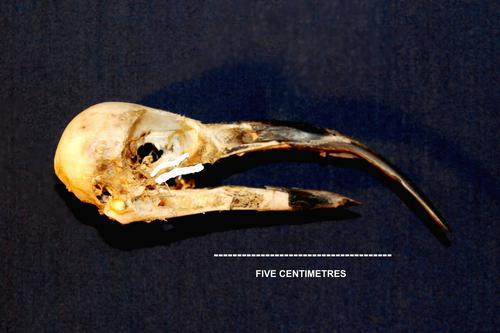An extreme beak aberration in a Jackdaw Corvus monedula L., 1758, from Broadway, Worcestershire
P.F. Whitehead
Jackdaws are time-honoured nesters in the chimney stacks of traditional Cotswold houses, including at Broadway village in Worcestershire. On 13th April 1983 I picked up a dead adult Jackdaw at Broadway with a markedly exaggerated overgrowth of the rhamphotheca, the keratinised beak sheath, of the premaxilla (Fig. 1.). The ornithological literature is peppered with accounts of similar, mostly more minor, aberrations which raise a number of questions, including how the overgrowth may have originated, and how the bird survived into adulthood.
The mandible articulates with the cranial occiput through small quadrate bones; these essentially allow the mandibular and maxillary bones to move up and down, the beak to open, and the condition of the rhampohothecae to be maintained in the normal way. Reinforcing rods, the jugal bones, pass from the base of the maxillaries below the orbits to meet the mandibular hinge joints. Without these and their attendant ligaments, a bird would be unable to move its beak.
In the case of this Jackdaw the right side jugal bone is atrophied to such an extent that it is almost separated into two (in Fig. 1. I have highlighted this bone between two thick white-coloured bars); the other is somewhat thickened. Here is the first clue to the aberration. There is no evidence that this Jackdaw was ever able to close its beak any further than shown in the accompanying figure. There is some evidence that the mandible, quadrate bones and occiput have become ankylosed or fused (any attempt to forcefully close the beak would effectively destroy the skull). Presumably this aberration is of congenital origin and worsened over time since there is no visible evidence of trauma.
How did the bird survive? Such an aberration could scarcely have happened to a more adaptable species of bird and the slight inclination of the downturn to the right lends some credence to a view that this bird may have learnt to feed with its head on one side perhaps making particular use of the tongue. When found the bird was clearly underweight but not emaciated.
Image
Fig. 1. Lateral view of aberrant skull of adult Jackdaw Corvus monedula from Broadway, Worcestershire, 13 April 1983. ©Paul Whitehead.
